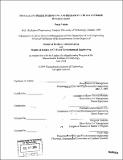| dc.contributor.advisor | Thomas Roemer and David Simchi-Levi. | en_US |
| dc.contributor.author | Vainio, Tanja, 1974- | en_US |
| dc.contributor.other | Leaders for Manufacturing Program. | en_US |
| dc.date.accessioned | 2006-11-08T16:36:52Z | |
| dc.date.available | 2006-11-08T16:36:52Z | |
| dc.date.copyright | 2004 | en_US |
| dc.date.issued | 2004 | en_US |
| dc.identifier.uri | http://hdl.handle.net/1721.1/34780 | |
| dc.description | Thesis (M.B.A.)--Massachusetts Institute of Technology, Sloan School of Management; and, (S.M.)--Massachusetts Institute of Technology, Dept. of Civil and Environmental Engineering; in conjunction with the Leaders for Manufacturing Program at MIT, 2004. | en_US |
| dc.description | Includes bibliographical references (p. 75-76). | en_US |
| dc.description.abstract | Dell's computer manufacturing process involves a complex system of material flow and assembly. This includes intelligent replenishment of sub-components from local warehouses according to the manufacturing schedule, just-in-time manufacturing of custom configured computer systems including hard-drive image and custom software download, packaging the unit for delivery, order accumulation, and finally, distribution and shipping to the customer. This thesis examines Dell's current order fulfillment process and suggests methods that can help Dell meet or exceed customers' delivery time air shipments to certain destinations could be converted to less expensive ground shipments. However, this is only possible when the entire fulfillment process is integrated in such a way that eligible ground shipments meet their appropriate shipping windows. This analysis shows that optimizing these windows not only requires an examination of the average cycle time in each phase but also of the impact that cycle time variations have on the expectations at minimum logistics cost in the just-in-time environment. By manufacturing and shipping products based on certain times of the day, success of this air-to-ground conversion strategy. Through the use of simulation models I found that the key factors in reducing logistics cost require setting appropriate scheduling rules for each order size and reducing the cycle time variation. | en_US |
| dc.description.statementofresponsibility | by Tanja Vainio. | en_US |
| dc.format.extent | 77 p. | en_US |
| dc.format.extent | 3843932 bytes | |
| dc.format.extent | 3843737 bytes | |
| dc.format.mimetype | application/pdf | |
| dc.format.mimetype | application/pdf | |
| dc.language.iso | eng | en_US |
| dc.publisher | Massachusetts Institute of Technology | en_US |
| dc.rights | M.I.T. theses are protected by copyright. They may be viewed from this source for any purpose, but reproduction or distribution in any format is prohibited without written permission. See provided URL for inquiries about permission. | en_US |
| dc.rights.uri | http://dspace.mit.edu/handle/1721.1/7582 | |
| dc.subject | Sloan School of Management. | en_US |
| dc.subject | Civil and Environmental Engineering. | en_US |
| dc.subject | Leaders for Manufacturing Program. | en_US |
| dc.title | Intelligent order scheduling and release in a build to order environment | en_US |
| dc.type | Thesis | en_US |
| dc.description.degree | S.M. | en_US |
| dc.description.degree | M.B.A. | en_US |
| dc.contributor.department | Leaders for Manufacturing Program at MIT | en_US |
| dc.contributor.department | Massachusetts Institute of Technology. Department of Civil and Environmental Engineering | |
| dc.contributor.department | Sloan School of Management | |
| dc.identifier.oclc | 56722079 | en_US |
